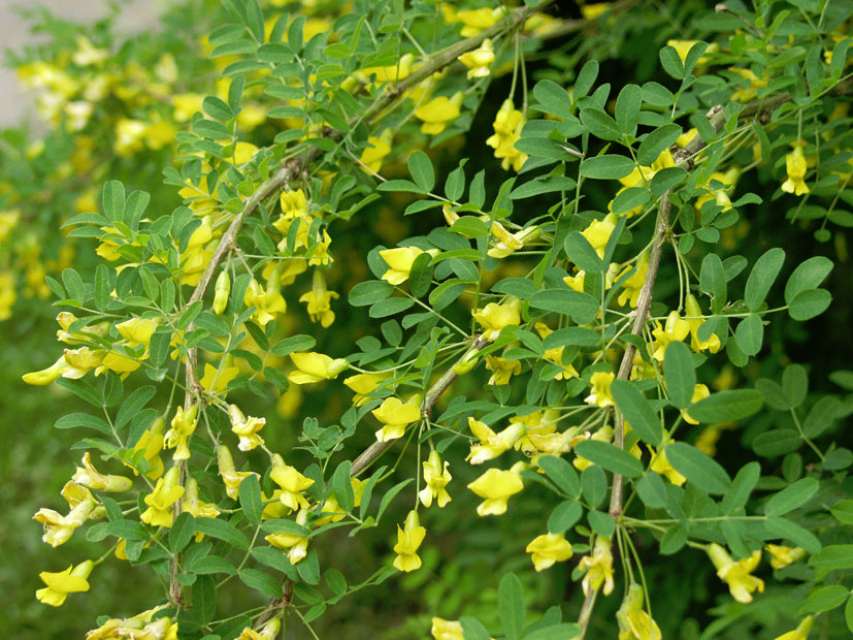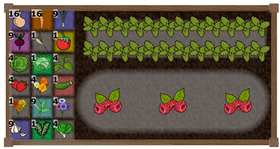I’ve just bought some Siberian Peashrub seeds. They’re becoming very popular with permaculture followers. It’s, as the name suggests, a shrub from Siberia that produces pea-like seeds in pods. Like a pea, they’re also a nitrogen fixing plant.

Siberian Peashrub – Image courtesy of Tree Seeds Online
The peashrub is fast growing, useful as a deciduous shelterbelt hedging plant and extremely hardy – as you’d expect from a Siberian plant. I think there’s a good chance they’ll thrive here. We rarely get really cold weather being near to the sea but the conditions are pretty challenging being windy and wet.
I read that the young peas and the pea-pods are edible when cooked but I think from other accounts that they’re one of those plants that are edible if you’re starving. Not a gourmet vegetable! Apparently chickens like the peas though, which tells me that other birds will appreciate them as a food source. The peas are 36% protein and contain 12% fatty oils – so pretty valuable as a food source.
Another benefit is that the flowers are useful for bees, providing nectar. The Siberian Peashrub is often grown as a decorative garden shrub.
Siberian Pea Tree for Regenerating the Land
Outside of the vegetable and fruit areas, I’m trying to regenerate the land. For many years all that’s happened is sheep have been run on it and they’d over-grazed it. So it’s poor-quality, weedy pasture with a lot of moss and weeds, very lacking in nutrients.
Being a fast-growing, nitrogen-fixing shrub, shedding its leaves each winter to add to the humus in the soil, the Siberian Peatree has to be the ideal plant as a windbreak around nutrient deficient land.
Where to Buy Siberian Peashrub Seeds
There’s a few people selling the seeds on Ebay but they were asking silly money. A little googling led me to Tree Seeds Online. They’ve a wide range of varieties of tree seeds and very economical prices.
Germinating Siberian Peashrub
Like many tree and shrub seeds, to germinate the Siberian Pea requires a period of dormancy followed by warmer, wet times. Replicating this process, which in nature ensures the seeds germinate at the right time to grow, is known as stratification.
According to the Tree Seeds Online web site, without stratification the germination rate will be lower than 10%.
Warm Water Treatment to Germinate Siberian Peashrub Seeds
The generally accepted method for Siberian Peashrub seeds is to soak the seeds in warm water (around 20ºC, room temperature) for a day. The warm water will soften the hard seed coating and cause the seed to swell to about twice the original size. Do not leave these seeds to continue soaking. Inside the seed the embryo has now quickened and the seeds should be sown immediately.
Some seeds will not have swollen so repeat the process using warmer water – not above hand-hot. DO NOT, as some sites suggest, use near boiling water. You may need to repeat this process again, removing swollen seeds to sow each day.
Cold Stratification of Siberian Peashrub Seeds
Stubborn seeds that have not swollen with the warm water method can be cold stratified. Make a mix of 50/50 seed compost and sharp sand or compost and vermiculite. Dampen (not soaking) the compost and mix in the seeds.
Put into a loosely tied polythene bag and place in a fridge for a month. Do not put in the freezer. This should finally convince the seeds it is time to wake up and grow when they’re removed.
Sowing Siberian Peashrub
Use a decent compost and sow shallowly into 3 inch (8 cm) pots about ½ inch deep (1 cm) or, as I am, using 12 cm deep root trainers. Keep at between 15 and 20ºC. The seedlings should appear in around 4 weeks.
They are fast-growing and should be ready to plant out in late summer from an early spring sowing. If not or sowed late, move on to deep rose pots or similar until planting out the following spring. With root trainers the seedlings will hold well and not need moving into larger pots.
Cultivation of Siberian Pea Trees
Do not use a general fertiliser, a little potash (as from wood ashes) will help but don’t pamper it. Do water in the first year if it’s a dry summer.
A light trimming after it is established will encourage it to bush out. With larger scale hedging windbreaks, just leave them to it.




Just make they’re not poisonous to sheep John!
They’re not – which means I have to work out how to keep the sheep away from them until they’re established.
This article reminded me that Philippinos grow a plant to use as greens which is good as a cholesterol lowerer, cardio-protective, and has many vitamins and minerals. It is a bit like a weed but can grow into a bush or even a tree. Here in Bahrain there are many growing on the roadsides and Philippinos pick the branches in the evenings to use as a basic vegetable I know that the seeds are available through Amazon and I am sure that with many Philippinos now working in the UK gardeners would be thanked if they grew some. The plant is Moringa Oleifera
I have had Siberian pea trees for years. I have sampled the seeds. They are ground as dried seeds for a flour, I have read. Taste is pretty bland. The problem I can see as a bird feed is that when the seeds are ripe, they sort of explode. I suspect the birds would have to scratch around on the ground to get the seeds. I never seem to have volunteer plants, so I suspect that the ones out where the chickens roam are eaten right up.
The one plant in the yard produces seeds every year, but I haven’t had volunteers there either.
Having said that, we are in the Nevada high desert country, and the trees have to be Tough to live here. We also have Russian olive trees that the birds really love the seeds from. Both of those trees are hardy, drought tolerant, and they will grow here. Neither are toxic to livestock.
Thanks for your input there, Kathy. Very interesting.
I urgently require two Siberian pea shrubs.
I would love to know where I can get one from rsvp
Google will give you many results
Hello! Thanks for the informative post. We live near Grand Forks, ND & have an established hedge of Siberian Pea Shrubs. They are very hardy; weather temps here range from 100F in summer to -45F in winter with extreme temp ranges in fall and spring. The shrubs are thriving & we plan on starting a new hedge from the current seed.
WOW! That’s pretty cold (-42ºC)A huge range between winter and summer